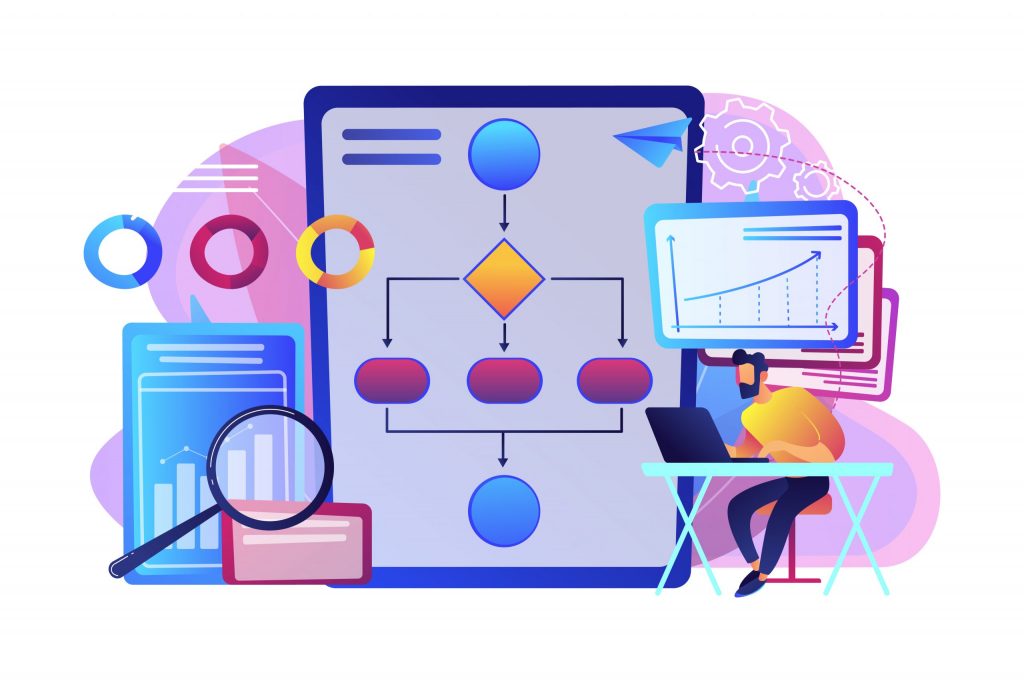
Analyst working at laptop with automation process. Business process automation, business process workflow, automated business system concept. Bright vibrant violet vector isolated illustration
It is time for organizations to lift digital transformation from platitudes and embed it in the product/service they provide and the way they provide it. It is no longer an option.
Some organizations and leaders who had the vision are ahead in the learning and value delivery curve, and for the others, the writing is evident on the wall. A digital transformation is no longer an option.
While as a leader, you cannot do much about how your organization led has been in the past, you still can grab the opportunity to accelerate your organization’s digital transformation so that you can move up from playing catch to being a leader.
Here is some advice on best practices we have studied:
Step 0 in digital transformation is fundamental to any transformation in decades that have passed us and decades to follow.:
- It is your understanding that DT is value-adding for your customer and your organization,your belief and authentic desire to create that value.
Once this is in place, the rest of the steps will be intuitive and relatively smooth, and obstacles will be easy to overcome.
1. Clarify the definition of Digital
It is very critical that as a leader, you can help your colleagues realize that digital is nothing too complex. Having a standard definition around this greatly helps in clearing the confusion. For example, one of the organizations we were working with defined digital in a straightforward manner- “Re-imagining customer journey or any process and making it simpler, scalable by leveraging technology”. This message, when cascaded frequently, made people realize that digital is not about technology first thinking; it is about customer-first thinking.
2. Aligning the structure
Any kind of transformation is hard to achieve without structural interventions. This is the same as digital transformation. Digital transformation specifically requires 3 teams to work very closely: Technology, Operations, and Customer Experience. While several organizations are able to a formal convergence of these units, at least an informal structural intervention is needed to facilitate accelerated transformation. Equally critical is establishing some centralized teams who can manage critical projects or centers of excellence (for example Data Scientists).
3. Organization processes
Digital transformation is hard to achieve if different functions have different ways of working. Therefore, adopting some key organization processes becomes critical to establish new ways. One such methodology is scrum. Several organizations view scrum as a process to manage IT projects. This is a very limiting view because the benefits of the scrum process (and underlying agile manifesto) can benefit the entire organization. Adopting scrum as an organizational process builds a common language and establishes routines and practices that any cultural interventions require. Another key process is design thinking, like scrum, this process is not just about new product development but a process to accelerate any kind of innovation.
4. KPI’s:
KPIs and metrics drive organizational behavior. One of the key issues most established organizations face (traditional may not be the best way to describe them), is that they have set KPI’s on which the organization has been reviewing performance for several years. Understandably, the mind of leadership gets wired to these KPI’s which impacts their focus. It is critical that the organization gradually starts introducing some digital KPIs so that performance can become more balanced. Here are some examples of digital KPI’s that an organization introduced:
a. Channel share of digital transactions
b. % decrease in manual transaction costs.
c. The income per digital customer
d. % increase in digital customers
e. % of successful digital innovations
5. Five cultural attributes
Culture is perhaps the most significant barrier to digital transformation. Through the work we have done, we have identified five cultural attributes that accelerate digital transformation:
a. Customer Obsession: Getting the organization to solve customer problems by technology
b. Data-Driven: Digital transformation requires leaders to frame opinions and views, not basis personal preferences but on data. Equally critical is leverage the value of this intangible asset.
c. Experimentation: Simply put, making the organization think “minimum viable product” is the goal here. Perfectionism reduces the base of digital transformation. Experiment increases the risk appetite.
d. Agility: This is not just about working with speed but also being open and changing your views when needed. Embedding this as a cultural attribute starts with leadership behavior.
e. Collaboration: Digital innovations are not created by one function. These require partnership across the company. The pervasiveness of collaboration drives the pervasiveness of innovation.
Enabling digital transformation can be a joyful or painful journey. By leveraging these 5 practices, you can not only accelerate digital transformation but make it joyful!








0 Comments